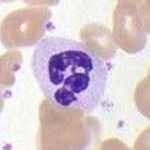Core shift
As a core shift is defined as a change in the differential blood count in terms of proportions of different developmental stages of neutrophils , a type of white blood cells (leukocytes) . It can occur in the direction of immature neutrophils (“shift to the left”) or more mature (“shift to the right”).
In the event of inflammation , the organism reacts with an increase in the total number of leukocytes ( leukocytosis ) and the number of neutrophils ( neutrophilia ). In the first six to eleven hours, this takes place through increased release of these cells from the bone marrow , where leukocytes are formed. After two to three days, there is an increased formation of neutrophils in the bone marrow.
Left shift
The increased occurrence of immature neutrophils is called reactive left shift . In addition to the functionally mature (so-called segmented neutrophils), precursors of leukopoiesis such as rod- nucleus neutrophils, metamyelocytes or myelocytes are increasingly appearing . This happens through the hasty release of these immature cells as a result of high consumption. For example, a reactive left shift is also found in most bacterial infections in the differential blood count.
There are two forms of reactive left shift:
- With the regenerative shift to the left , the number of rod-shaped (immature) is lower than the number of segmented nuclei. The total number of neutrophils is increased (leukocytosis).
- With the degenerative shift to the left , the number of immature cells (rod nuclei) is higher than that of segment nuclei. The total neutrophil count is decreased ( neutropenia ) or normal.
A left shift without neutrophilia indicates that there is an increased consumption of these cells that is no longer fully covered by new formation in the bone marrow. In this case, a new blood test is advisable. If the neutrophils are increased on this second examination and the left shift has normalized again, the prognosis is good. However, if there is a decrease in neutrophils or an increase in the left shift, a very serious disease is the likely cause.
A pathological shift to the left describes a shift to the left that can go as far as the myeloblasts, which represent the most immature stage of granulopoiesis , belong to the pure proliferation compartment and, under physiological circumstances, do not leave the bone marrow due to their complete lack of defense. The pathological shift to the left occurs especially in primary blood diseases (leukemia) and in the acute phase is often associated with leukocytosis or even hyperleukocytosis .
Right shift
With a "right shift" the aged neutrophils, so-called hypersegmented neutrophils , increase. This can occur as a result of decreased neutrophil migration from the blood vessels, e.g. B. by increasing the endogenous production of glucocorticoids or the administration of glucocorticoids used as anti-inflammatory agents.
Individual evidence
- ^ Douglas J. Weiss, K. Jane Wardrop: Schalm's Veterinary Hematology . 6th edition. John Wiley & Sons, New York, NY 2011, ISBN 978-0-470-96183-4 .
-
↑ Herbert Hof, Rüdiger Dörries: Medical Microbiology . Dual series, 4th edition. Thieme, Stuttgart / New York 2009.
Klaus Dörner: Clinical chemistry and hematology . 7th edition. Thieme, Stuttgart / New York 2009.

